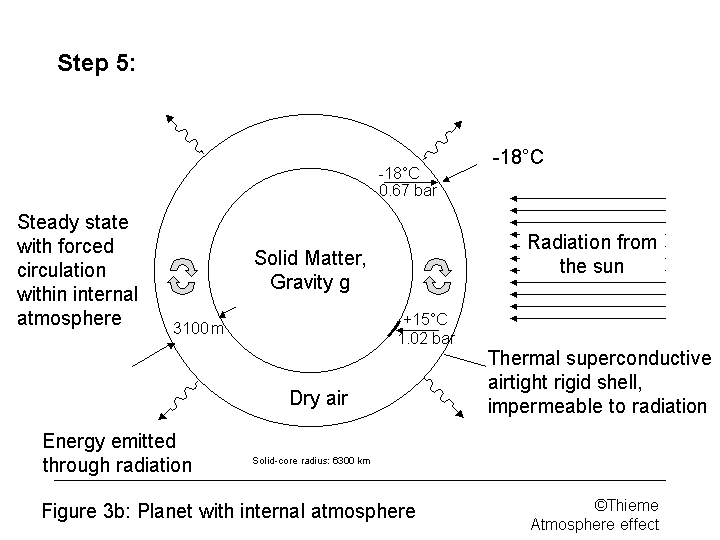To understand basic
thermal conditions within an atmosphere:
IPCC, Climate Change, The IPCC Scientific Assessment,
1990,
Report
Prepared for IPCC by Working Group 1, Radiative Forcing of Climate, p. 49:
“It is
not the change in thermal infrared flux at the surface that
determines the strength of the greenhouse warming. The
surface, planetary boundary layer and the free troposphere are
tightly coupled via air motions on a wide range of scales, so that
in global-mean sense they must be considered as a single thermodynamic system. As a result it is the
change
in the
radiative flux at the tropopause, and not the surface, that
expresses the radiative forcing of climate system."
The Thermodynamic Atmosphere Effect
- explained stepwise
It's thermodynamics what determines Temperature, weather and climate on Earth
©
by Heinz Thieme
German Version: http://real-planet.eu/atmoseff.html
Using a set of technical models of planets with and without an atmosphere the reasons are explained for differences in surface temperature of the planet without an atmosphere compared with the temperature in the ground layer of atmosphere of the other planet. The differences are caused by thermodynamic characteristics of these gases, which cause the mass and the composition of the atmosphere, and the atmospheric pressure, which results from gravity.
1. Obscure reality
It is known that under the climatic conditions on earth life is possible. However it is still unknown why these beneficial conditions for life are effective here. Uncertainty also exists, as to whether the actual climatic conditions will be influenced considerably by humans. A discussion of these questions above apparently has only taken place so far in closed circles, because the announced ideas of forthcoming climatic modifications caused by humans seem to be derived, neglecting basic knowledge in physics.
In particular, the explanations concerning the temperature on earth given by "climatology" refer to the discrepancy between surface temperatures of planets with and without an atmosphere. Using radiation equations, they calculate the surface temperature up to 255 K (-18°C) of a fictitious planet, that is comparable to our earth with respect to position and movements in the solar system, as well as reflection characteristics of its surface, but without an atmosphere. The temperature at the bottom of our atmosphere, so for instance at 2 m above sea level, however is said to be on average globally 288 K (+15°C), this value results from measured data. The difference of 33 K between both values is defined widely as the "greenhouse effect" [1]. The causes for this difference in temperature, given by climatology explanations, shall be the impact of trace quantities of “optically active” gases (“greenhouse gases”) in the atmosphere, which shall obstruct the thermal radiation leaving the earth towards space. The atmosphere shall be heated up due to this, so that it is found that at the bottom, the temperature is around 288 K, 33 K greater than the planet without an atmosphere should have at its surface. However, climatology can still not explain the warming effects of “greenhouse gases” in understandable way.
Energy input to the system comes from solar radiation to the earth's surface. The energy received is removed through the significant transfer mechanisms of evaporation and convection. Also radiation removes the energy received, although radiation is comparatively insignificant at the bottom of the atmosphere. The quantities and qualities of these energies are presumed to be known. (A rough outline of the energy flows in the atmosphere is given in [2].)
It is inevitable that the temperatures at the bottom of an atmosphere of a planet are higher compared to the temperatures at the surface of a planet without an atmosphere. Even if two planets in the solar system are compared that are of equal position, equal movement, besides being equipped with identical reflection and absorptive properties, the temperature near the surface of the planet with an atmosphere must be higher than the surface temperature of the one without. This will be explained in the following through very simple examples. It is a logical necessity that the temperature within the near-surface area of the planet with an atmosphere is to compare to the surface temperature of the planet without an atmosphere. As even at a minimum distance to the surface of the planet without an atmosphere, there is already no temperature in the thermodynamic understanding, due to the lack of matter.
2. Model planet without an atmosphere
As a first step to explain the general perspective, Fig. 1 shows a planet, which is in an identical position in the solar system as to our earth, but has no atmosphere. Absorption and reflection characteristics of the surface of this planet shall be identical to those of the earth, that is of earth's surface and atmosphere at total view. In order to be able to neglect the effects resulting from the rotation of the earth or planet, it is assumed additionally that the surface of the planet consists of a thermal superconductive shell, i.e. all places on the shell have identical temperatures always. Moreover the shell shall be impermeable to radiation, gas, pressure and completely rigid.
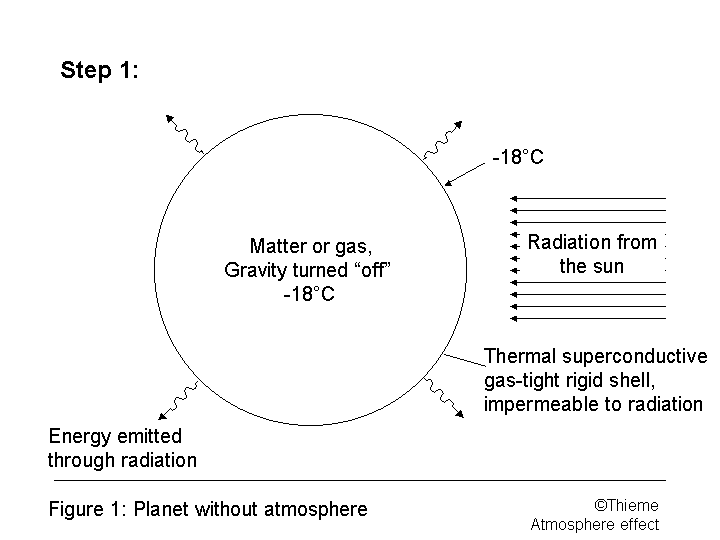
As a result of the existing thermal radiation from the sun and radiation from the surface into space, that leaves from the entire surface, the temperature of the surface would appear at the level of 255 K (-18°C), a value that is often calculated. In Fig. 1 two more assumptions are specified, but these do not have effects on the temperature of the planet’s surface: The whole interior of the planet, below the planet’s shell, is filled either with gas or solid matter, but no gravitational effects exist, gravity is switched “off”. Within the shell, as a result of thermal conduction and also thermal radiation, the temperature of the matter will to adapt the temperature of the shell, 255 K (-18°C).
The second step is to modify the interior of the planet: It is assumed to be a core of solid matter with the dimensions of the earth, and the gravity of this core shall be equivalent to that of the earth, g. The covering shell, still equipped with same characteristics as before, is positioned a few km above the surface of the fixed core. Between the shell and solid core is a vacuum. The temperature of the shell is still the same as before (255 K; -18°C). The temperature at the surface of the fixed core will adjust to the same 255 K (-18°C) of the shell, due to heat transfer through the vacuum by radiation from the shell. In the vacuum between shell and solid core there is no temperature because of the absence of matter (Fig. 2a). If an exchange of energy takes place between the covering shell and solid core, this occurs exclusively by radiation.
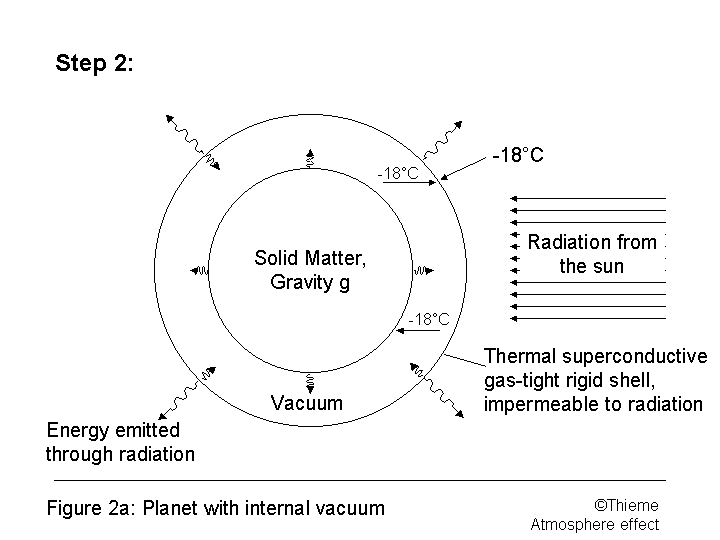
3. Model planet with air layer on the inside.
The next step is shown in Fig. 2b. The planet’s shell has all the assumed properties (infinite heat conductivity, impermeable to radiation, gas-proof, pressure-proof and completely rigid). But it is assumed that gravity is switched “off” again. The vacuum between the shell and solid core is replaced by dry air under a light pressure, of about 0.78 bar. The distance between the solid core and the shell is determined to be 3100 m. In the interior there is also the solid core with the dimensions of our earth, however there is no water. The heat exchange between the surface of the core and the planet’s shell can take place only via radiation and thermal conduction. Convection does not occur, since the different densities of colder and warmer air cannot create a movement of air particles because the solid core is without gravity. The temperature, at the planet's shell, within the air layer and at the core, adjusts uniformly to the temperature of the shell, thus to 255 K (-18°C).
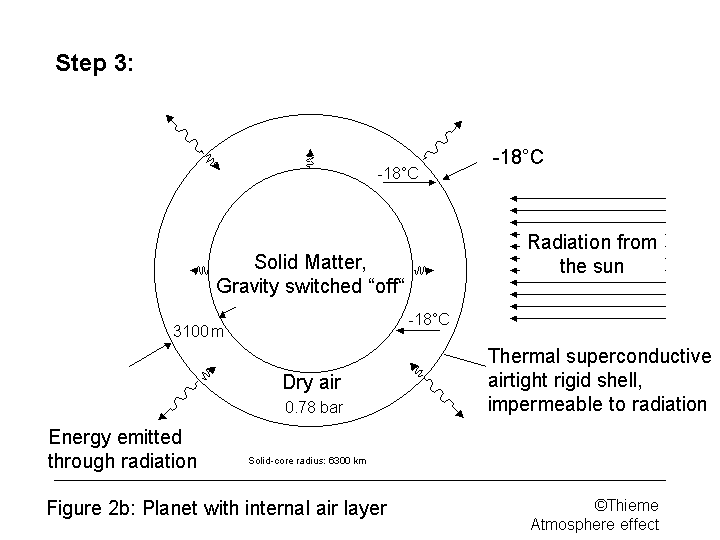
4. Model planet with atmosphere on the inside - version 1
In the next, the fourth, step only the gravity of the solid core is switched “on” while, all other conditions remain unchanged as in Fig. 2b. The gravitational force of the solid core is to correspond to that of the earth, g. Fig. 3a shows the conditions immediately after switching the gravity ”on". While in the air layer the pressure of 0,78 bar and the temperature of -18°C prevailed before, the gravity causes that the conditions of temperature and pressure change. Now the mass of air is no longer distributed equally in the area between shell and core. Near to the core the density of the air is now higher, because of the pressure of the weight of the air mass that lies over it. The pressure within the air near to the core rose to 1,02 bar now.
Also the temperature in the air near the core, for example at the level of 2 m over the soil, that is usual for temperature measurement, is risen to +1°C. In the air layer closely underneath the shell of the planet however, because of by the force of gravity caused partial shift of air masses nearer to the core, the air pressure dropped to 0,67 bar. Also the air temperature decreased here; it amounts now, again in approximately 2 m distance to the shell only -29°C. The temperature differences are exclusively caused by the compression work carried out by the gravity (respectively decompression work below the shell).
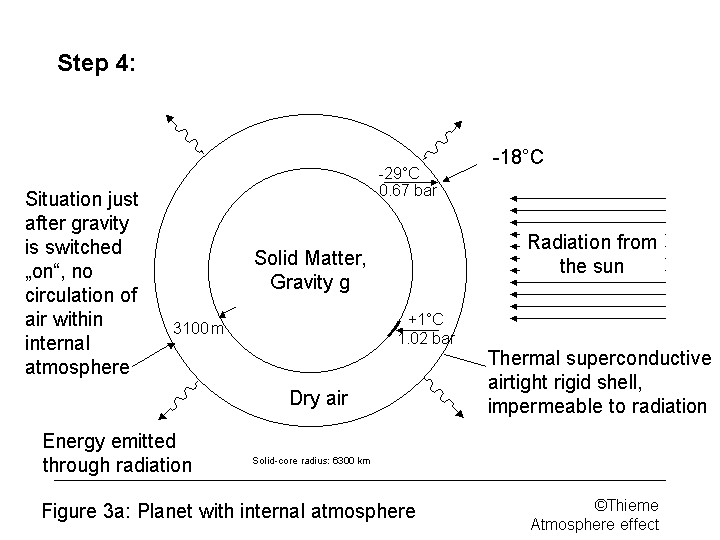
If both the surface of the core and the inside of the planet’s shell were made of perfect heat insulating material and if no cause would exist for a forced circulation of air within the layer, then the temperatures represented in Fig 3a would remain for that state. If one would switch “off " the gravity however again, then immediately the conditions of temperature and pressure found before switching “on" of the gravity would reset themselves.
In the next, the fifth step now it is assumed that the gravity remains switched “on". Furthermore it is supposed that a forced circulation (e.g. by blowers) takes place within the air layer, in addition both the surface of the core and the inside of the shell are of thermal conductive material again. In consequence of the circulation of air and thereby possible heat transfers through convection heat is to be transferred from the inside of the shell to the air as well as from air to the surface of the core. After steady state has been reached, then the temperature and pressure conditions shown in Fig. 3b are observed: The air pressure at the inside of the planet’s remains at about 0.67 bar, the temperature at this position rose to 255 K (-18°C), the temperature of the shell. At the surface of the core however the air pressure reaches 1.02 bar and the air temperature there climbed to 288 K (+15°C). This difference of the temperature at the surface of the solid core to the temperature of the shell is due to the force of gravity of the core and the weight of the air above.
Because a circulation of air is assumed to occur within the air layer, this
causes the change of location of individual volumes of air. Their temperature
increases when descending from the shell down to the solid core due to rising
air pressure and vice versa (comp. [3]), which is caused by gravity. If an
airmass sinks from just under the shell towards the solid core,raising its
pressure to 1.02 bar, its volume decreases to 74% of its initial value, and its
temperature rises by 33 K to reach 288 K (15°C). In nature, the warming
of descending airmasses through compression is illustrated by the Foehn winds
that blow down from mountain tops in special meteorological situations (see
footnote Foehn Wind ).
If the regarded air volume part arrives through further change of location to a place just below the shell, then it achieves its initial state (pressure, temperature, volume) again through the reversal of the resulting changes. The relationships between pressure, volume and temperature for gases, during the described change in position of a volume of air and without any heat exchange with the environment (adiabatic change of state), are described with the following equations:
General gas equation p x v = R x T
Adiabatic change of state p x v k = constant
or T x v k-1 = constant
k = relation of the specific thermal values cp to cv
The variation of air temperature with height in the air layer, shown here, results from the interaction of temperature, pressure and volume alone. The only reason for the change in pressure with height is gravity of the solid core.
In the model no energy can enter from outside through radiation, as the shell is impermeable to radiation. Also a transfer of energy by radiation from the shell inward cannot take place, because near to the core the temperature is higher than that of the shell. In this example the solid core only can achieve a temperature, that is somewhat below that of the bottom most air layer through convection (and in small amounts also by radiation from surrounding air), thus not completely attaining 288 K (+15°C). This is caused again by the release of energy from the solid core by slight radiation towards the colder shell.
It is learnt from this model, that at the bottom of the considered air layer the temperature is around 33 K higher than at the planet’s shell. No radiation from the outside would find a way through the covering shell. Inside there is only low thermal radiation leaving from the solid core, which does not have a considerable effect on the temperature gradient within the air layer. The higher temperature at the ground of the air layer is caused alone by the thermodynamic changes in state of air.
In the air layer, that is an atmosphere, which has gas characteristics throughout, there exists a negative temperature gradient in the direction of core to shell. This gradient has exclusively thermodynamic causes, it is not at all due to any thermal radiation towards the covering shell or space. The above example is consciously selected in such a way that the temperature 288 K (+15°C) at the bottom of the air layer is achieved - as it is at the bottom of the atmosphere on our earth. The example illustrates approximately the situation of the earth in the space. The equivalent temperature of the earth’s radiation (surface and atmosphere), measured by satellites, amounts to 255 K (-18°C) [4]. If we had no humidity in the terrestrial atmosphere, then the substantial boundary conditions of the temperatures in it were already to a large extent explained.
5. Planet model with atmosphere on the inside - version 2
Next (the 6th step), the same planet model as before shall be regarded, however the planet’s shell is still impermeable to radiation, airtight, pressure-tight and completely rigid. But the heat conductivity is reduced to a very low level, so along the covering shell substantial temperature differences occur. As before, the planet is in a stationary position relative to the sun.(Fig. 4).
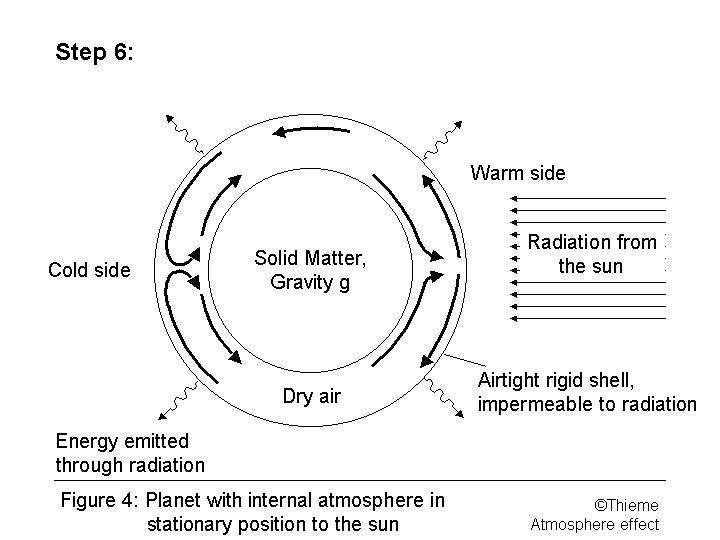
Due to the correction of the temperature differences between the side irradiated by the sun (the warm side) and the side turned away from the sun (the cold side) violent movements now occur within the air layer. This is known in the atmosphere as low pressure (warm side), high pressure (cold side) and wind. All this takes place without any penetration of radiation from the sun through the covering shell of the planet, and with only insignificant amounts radiation into the shell from the solid core.
If the model of the atmosphere inside the planet’s shell is now enriched with humidity, then there will be weather. On the warm side, water at the surface of the solid core evaporates, i.e. it ascends with the air from the surface of the core and moves upward towards the colder zone. In this way it condenses with the resulting cooling, i.e. cloud formation, on the cold side it rains, the humidity condenses to a large extent and runs along the surface of the core to the warm side. In this way, the "Heat Pipe" heat exchanger system [5] functions with this principle.
As the situation shall approach reality, the covering shell is to replace by an additional atmosphere, which is so weighty that at its ground the pressure is 0.67 bar. Furthermore, the absorption and reflection qualities of the previous covering shell must remain over entire the planet (now resulting from the surface and complete atmosphere). The temperature conditions at the bottom of the atmosphere and their causes are not changed by this modification. The planet now radiates at an average temperature of 255 K (-18°C) into space, whilst at ground level the average temperature is 288 K (+15°C).
Actual conditions in our atmosphere are substantially complicated (comp. [6]) by the earth's rotation, obliqueness of the earth’s axis and in addition, by varying locally the moisture contents of the atmosphere and their physical states. Beyond that the radiation from the sun, at least those proportions of it which reach the earth’s surface, lead to a substantial supply of heat to the receiving points. This supply of heat and the removal of that energy at the same time by evaporation of water, convection and radiation cause the daily oscillation of the air temperature. The energy radiated down to the surface of the earth is released again into space in the three ways mentioned, at least to higher air layers and delivered in the long run as radiation into space. The basic relationships explained here universally apply even with the complications of the terrestrial atmosphere.
6. Consequences and further considerations
With the examples based on simple models, it is shown that the higher temperature at the bottom of a planet’s atmosphere than of the surface of a planet without atmosphere is inevitable and is induced by atmospheric pressure. In the same way the lower temperatures in the atmosphere’s upper areas are caused by lower pressure.
From this it can be concluded that the conditions of temperature at the soil of an atmosphere are affected by the thickness (mass and pressure) of the atmosphere. (Very similar conclusions can be found in [8], see appendix.) If we had more terrestrial atmosphere, which has - standardized on the pressure in sea level - the thickness of just about 8 km only, then it would be warmer on earth. Consequently it would be colder here, if the terrestrial the atmosphere were less thick. Because the main components of our atmosphere, nitrogen and oxygen, are present on earth in chemical compounds in liquid, dissolved as well as in solid state too, it can’t be excluded that the thickness of the atmosphere in periods of earth-history could have changed. Possibly variations in temperature and thus climatic changes in earth-history could be caused by changes of the atmosphere volume, i.e. changes of the atmospheric mass.
Gases within an atmosphere show the same effects as in multi-stage compression: the higher the pressure (towards the surface), the warmer it gets. The temperature profile within an atmosphere is independent of the absorption of radiation throughout the atmosphere. Also without any absorption of radiation within an atmosphere, higher temperatures will be observed at the bottom of the atmosphere, than they would appear outside of the atmosphere and measured from the planet's radiation inclusive of its atmosphere or calculated by use of radiation equations.
The cause for the higher temperature at the base of an atmosphere it is that the removal of energy from the atmosphere toward space occurs essentially via radiation from the upper layers of the gas atmosphere, where the transition from the gas state into a vacuum-like state takes place, on the basis of temperature. At lower altitudes, the laws of thermodynamics apply for the gas atmosphere, which means that with increasing gas compression its temperature rises. The increasing pressure with decreasing distance to the planet's surface is caused by gravity.
Thus gravity essentially determines the temperature conditions within an atmosphere.
Atmospheric temperatures can be calculated using thermodynamic laws (general gas equation, adiabatic change in state) and considering in particular the changes in the humidity content and their physical states.
The considerations here show that without absorption of radiation within the water-free atmosphere similar conditions of average temperature occur as in the terrestrial atmosphere. Therefore the contribution of radiation absorption can only be of subordinate importance to the average temperature in the atmosphere.
After [1], traces of optically active gases alone are used to determine the temperature in the atmosphere. Such statements are forbidden, if the thermodynamics are not to be taken as nonsense.
The
hypothesis on the effects of CO2 concentrations in air
on temperature is often derived (as in [7]) from conditions on Venus with its
CO2 atmosphere there. If one assumes that in the above, as 5th
step presented model, instead of air a gas layer of CO2 is present and the pressure on the ground of this atmosphere is
90 bar, no matter whether it is caused by the thickness of the gas layer or the
gravity of the solid core, then at ground level a temperature of approx. 733 K
(+460°C) would exist. This is an example of Venus's atmosphere, also there is
practically no influence from absorption of radiation within the atmosphere.
There
is one point worth noting in the case of Venus: If the atmosphere on Venus did
not predominantly consist of CO2, but of air, then it would be
around about 200 K warmer there, with assumed unchanged pressure ratios. The
cause for this is the somewhat smaller k value for triatomic gases (k Air: 1.4; k CO2: 1.3).
To
avoid misunderstandings in the future it would be wise not to use the term
"greenhouse effect" anymore for the description of conditions within
an atmosphere. It would be more correct to speak of an "Atmosphere Effect"
[6], to describe and explain the thermodynamic temperature effects of an
atmosphere.
Since
temperature conditions within an atmosphere are determined almost exclusively
by thermodynamics, it may be difficult to speak in the future of a warming up
effect in mankind's habitat by higher trace gases contents, such as CO2, in the atmosphere.
Proportions
of so-called " greenhouse gases ", CO2 (mainly) and also O3, N2O, CH4, have at most
insignificant effects on the temperatures at the ground level of an atmosphere.
Accordingly fluctuations of the proportions of the above mentioned gases in the
atmosphere can have only smaller, i.e. practically none, effects.
List of sources:
[1] Deutsche Meteorologische Gesellschaft, Die Basis des anthropogenen Treibhauseffektes: Veränderte Strahlungsflüsse in der Atmosphäre, KI Luft- und Kältetechnik, 8/1999, p. 411-412
[2] Thieme, H., CO2-Beitrag zur Klimaerwärmung: Grundlagen zweifelhaft, Klima 2000, No. 11-12 1997, p. 33-37
[3] Salby, M. L., Fundamentals of Atmospheric Physics, Academic Press Inc., 1996, p.71
[4] Information from Christy, J. R., Earth System Science Center, University of Alabama, Huntsville
[5] Adamczyk, K., Hesel, U., Dittmann, P., Einsatz von Heat-Pipe-Wärmetauschern in Kraftwerken und Müllverbrennungsanlagen, lecture, VGB-Congress Power Plants 1999
[6] Thieme, H., Treibhauseffekt ohne wissenschaftliche Grundlage, Elektrizitätswirtschaft, Jg. 98 (1999), Heft 20, p. 8-12
[7] Houghton, J., Global Warming, Lion Publishing plc., 1994, p. 24-25
Related papers:
Greenhouse Gas Hypothesis violates Fundamentals of Physics
see: http://realplanet.eu/error.html ,
The Phenomenon of the Atmospheric Backradiation
see: http://realplanet.eu/backrad.html ,
Do Men really affect Weather and Climate? Are the Interactions really understood?
see: http://realplanet.eu/Influence.html .
The author is co-author and belongs to the initial signers of the Climate Declaration of Heiligenroth (Klimamanifest von Heiligenroth)
see: http://www.klimamanifest-von-heiligenroth.de/klimaman-e.html#
[8] Appendix:
Wind Controlled Climate
Doctoral Thesis by Hans Jelbring,
hans.jelbring@telia.com
A short presentation
Climatic variability is analysed, seen from a wide perspective. The problems involved have been subjectively defined and a solution is sought. Limiting factors as the incomprehensibility of systems, the errors in proxy variables, the inadequacy of general circulation models and lack of interdisciplinary research are taken into account. It is especially important to notice that the physical processes controlling climatic variability is not fully identified and understood at our contemporary level of scientific knowledge. This thesis hopefully contributes to decrease the missing amount of knowledge necessary to describe climatic variability in terms of cause and effect.
A basic simple energy flow model, is proposed to identify the most important energy flows in Earth climate system and subsystems. Observational evidence is discussed in relation to identified and defined subsystems, in relation to selected important processes and finally relating to results from simple model.
It is concluded, that several processes exist and that different processes are dominating in different time scales and also in the hemispheres. Thus, it is strongly suggested that during the longest time scale, the dominating process depends on changes in atmospheric mass. Global cold climate is proposed to develop primarily as a consequence of increased infrared emission from Northern hemisphere in combination with increased atmospheric circulation intensity.
Global energy storage is proposed to be controlled by global land-ocean distribution and to be dominated by sensible heat storage in Southern hemisphere oceans. Deglaciation is proposed to occur as a consequence of large-scale interhemispheric exchange of mainly Atlantic Ocean water, cold northern Atlantic water being replaced by warm southern Atlantic water. Interglacials (or shorter warm periods) are proposed to be sustained by large scale atmospheric energy transfer from Southern hemisphere to Northern hemisphere during Northern hemisphere winters, a process that is switched on and off in time scales hundreds to thousands of years for reasons that are not understood.
Infrared energy emission is dominating in Northern hemisphere and ocean energy storage is dominating in the southern one. These energetic inequalities between hemispheres, might establish a theoretical basis to understand why orbital eccentricity variations can modulate the amplitude of the 100 ky glacial-interglacacial cycle, despite the fact that each hemisphere on a yearly basis, receives about equal amounts of insolation.
Hemispheric relocations of stored sensible heat in the atmosphere and hydrosphere, are suggested to dominate glacial–interglacial variations on Earth and also changes of much shorter duration. Two physical processes have been identified as contributing to energy relocation making it easier to describe climatic variability as a cause and effect relationship. Intermittent relocations of stored sensible heat are suggested to be triggered by tidal factors. It is also suggested that much relevant information can be gathered from observations of atmospheric motion on Sun and proper planets.
© Hans Jelbring, Wind Controlled Climate, Paleogeophysics & Geodynamics, Stockholm University, 1998,
ISBN 91-7153-790-2
The relative warmth of the Foehn arises from the different heat response rates of moist and dry air. Moist air ascending (for example in Europe) the south side of the Alps soon cools to dewpoint and thereafter its rate of cooling is slow (about 0.6°C per 100m altitude) as it sheds its moisture by condensation. The air is dry when it reaches the summits, and as it descends the other side it warms at the faster rate of dry air (about 1°C per 100m altitude). By the time it reaches the transalpine valleys, it has typically warmed to 13°C, whereas it was only 5°C as moist air at the same altitude during its ascent of the south side of the mountains.
See also: http://www.top-wetter.de/lexikon/f/foehn.htm (in German).
The article “The Thermodynamic Atmosphere Effect” was originally published in Fusion No. 3/2000.
This Website was created originally: 10.01.2001, the appendix was added: 12.05.2001, latest supplement (Klimamanifest): 09.10.2007, transfer to http://realplanet.eu : 07.03.2010, subtitle added 26.11.2018
